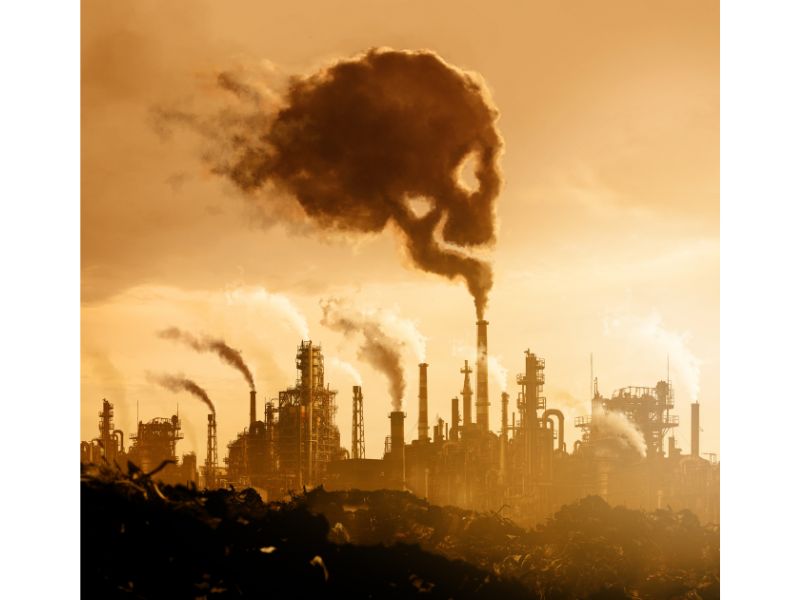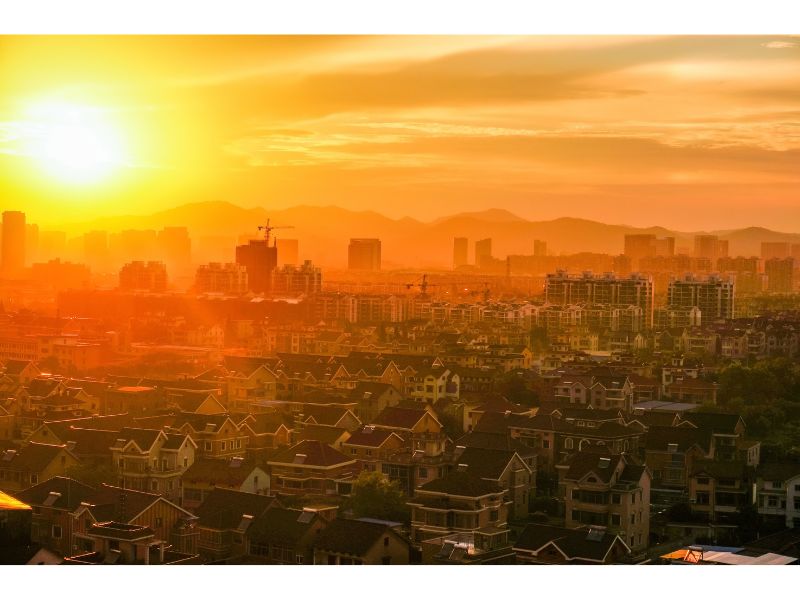
Climate change is no longer a distant threat—it is a present-day crisis. India, with its diverse geography and dense population, is among the countries most vulnerable to the effects of climate disruption. Understanding the root causes of climate change in India is crucial for building sustainable policies and creating awareness.
In this article, we’ll explore the primary contributors to climate change in India, discuss human-induced and natural causes, and analyze their environmental and social impacts. This comprehensive guide is written to help students, researchers, and environmentally conscious citizens understand the key drivers of India’s climate crisis.
What Is Climate Change and Why Is It a Concern in India?

Climate change refers to long-term shifts in temperatures and weather patterns, primarily due to human activities such as burning fossil fuels. In India, it translates to more frequent heatwaves, erratic monsoons, rising sea levels, and increasing droughts and floods.
India’s economy, ecology, and society are intricately tied to climate stability. Agriculture, which employs over 50% of the population, is highly climate-sensitive. Hence, identifying the key reasons behind climate change in India is vital for long-term sustainability.
Top Causes of Climate Change in India
Below are the major factors contributing to climate change in India, explained in detail:
1. Industrial Emissions and Greenhouse Gases

Industrialization and CO₂ Emissions in India
India’s rapid industrial growth has led to a sharp rise in greenhouse gas emissions. Factories and power plants rely heavily on fossil fuels—primarily coal—for energy generation.
- Coal-powered plants are the largest sources of carbon dioxide (CO₂), a major greenhouse gas.
- Steel, cement, and chemical industries also contribute significantly to GHG emissions.
Why Industrial Pollution Matters
Industrial pollution contributes to:
- Rising temperatures
- Air pollution (PM2.5 and PM10)
- Acid rain
- Ozone layer depletion
This accelerates global warming in India, impacting both urban and rural populations.
2. Vehicular Pollution and Urban Transportation

Increasing Number of Vehicles on Indian Roads
India’s urban population is rapidly growing, and so is its vehicle population. With millions of cars, buses, and two-wheelers emitting pollutants daily, cities like Delhi, Mumbai, and Bengaluru face critical air quality issues.
Fossil Fuels and Transportation Emissions
- Petrol and diesel engines emit CO₂, methane (CH₄), and nitrous oxide (N₂O).
- Traffic congestion further worsens emissions.
Public transport alternatives and electric vehicles are still in their infancy, making vehicular emissions a primary driver of climate change in urban India.
3. Deforestation and Loss of Forest Cover

The Impact of Forest Degradation on Indian Climate
India’s forests act as carbon sinks. Deforestation for agriculture, mining, infrastructure, and illegal logging is shrinking India’s green cover.
- Between 2001 and 2020, India lost over 18% of its tree cover.
- Forest fires, urban expansion, and road development contribute heavily to this.
Consequences of Tree Loss
- Less CO₂ absorption
- Biodiversity loss
- Soil erosion and desertification
- Changes in local rainfall patterns
This directly contributes to environmental imbalance and climate change in India.
4. Agricultural Practices and Methane Emissions

Rice Cultivation and Livestock: A Silent Contributor
India’s agriculture sector emits large quantities of methane—a potent greenhouse gas.
- Paddy fields release methane during anaerobic decomposition.
- Livestock such as cows and buffaloes emit methane through digestion (enteric fermentation).
Fertilizer overuse also leads to nitrous oxide emissions, another contributor to the greenhouse effect.
Why Agricultural Emissions Matter
- Methane is 25x more potent than CO₂.
- Overuse of chemical fertilizers depletes soil health and releases harmful gases.
This makes agriculture a leading cause of India’s climate woes, despite being a livelihood source for millions.
5. Construction Boom and Urban Heat Islands

Real Estate Development and Environmental Stress
Rapid urbanization leads to massive construction of buildings, roads, and bridges. This has created urban heat islands—areas where temperatures are significantly higher than surrounding rural areas.
- Concrete absorbs more heat than natural landscapes.
- Loss of vegetation intensifies heat buildup.
Energy Consumption in Urban Areas
- Air conditioners, refrigeration, and lighting in modern buildings use large amounts of electricity, mostly generated from non-renewable sources.
This results in heat entrapment and increased energy demand, both of which are contributors to urban climate change in India.
6. Energy Production from Fossil Fuels

India’s Energy Mix: Still Coal-Dependent
Despite strides in solar and wind energy, over 55% of India’s electricity is still coal-generated. The thermal power sector emits vast amounts of:
- Carbon dioxide
- Sulfur dioxide
- Fly ash and particulate matter
Consequences of Fossil Fuel Dependency
- Air and water pollution
- Respiratory diseases
- Increase in average surface temperature
Transitioning to clean energy is essential to reduce India’s carbon footprint.
7. Waste Management and Landfill Gases

Unmanaged Waste and Its Impact on Climate
India generates over 62 million tonnes of municipal solid waste every year. Improper disposal and open dumping result in:
- Methane emissions from landfills
- Water and soil contamination
- Air pollution through open burning
E-waste and plastic waste also contribute to chemical pollution and ocean degradation.
Proper recycling, segregation, and bio-waste conversion can mitigate these issues and curb climate change induced by waste.
Natural Causes of Climate Change in India
Although most causes are anthropogenic, some natural factors also play a role in India’s climate variability:
1. Volcanic Activity
Volcanic eruptions can inject particles and gases into the atmosphere that influence global temperatures temporarily.
2. Ocean Currents and El Niño
Changes in ocean currents like El Niño affect India’s monsoons and can trigger droughts or floods.
3. Solar Radiation
Fluctuations in solar energy reaching Earth can cause minor climate shifts, although this plays a smaller role compared to human activity.
Consequences of Climate Change in India
Understanding the causes is incomplete without knowing the effects. Here’s how the climate crisis impacts India:
- Irregular monsoons affecting crop cycles and water supply.
- Frequent heatwaves with temperatures above 45°C, especially in North India.
- Melting Himalayan glaciers, endangering rivers like Ganga and Yamuna.
- Cyclones and floods disrupting coastal regions like Odisha and West Bengal.
- Rising sea levels threatening cities like Mumbai, Chennai, and Kolkata.
India’s Role in Tackling Climate Change

India is taking steps to mitigate climate change through:
- The National Action Plan on Climate Change (NAPCC) with missions on solar energy, energy efficiency, and sustainable agriculture.
- International commitments like the Paris Agreement and COP26 pledges to achieve net zero emissions by 2070.
- Renewable energy targets, aiming for 500 GW of non-fossil fuel capacity by 2030.
- Afforestation campaigns, clean energy subsidies, and public awareness drives.
How Can Individuals Help Fight Climate Change in India?
Apart from governmental efforts, citizen action is crucial. Here’s what individuals can do:
- Use public transport or cycle
- Save electricity and switch to renewables
- Reduce meat and dairy consumption
- Plant trees and avoid single-use plastics
- Support eco-friendly brands and vote for climate-conscious policies
Conclusion: Combating Climate Change Starts with Awareness
The causes of climate change in India are deeply linked to our industries, lifestyles, and development models. While growth is essential, it must be sustainable. By understanding the sources—from vehicular emissions and deforestation to agriculture and waste—we can make informed decisions that safeguard our planet for future generations.
Climate change is not just an environmental issue—it’s a health issue, an economic issue, and a survival issue. India’s fight against climate change begins with awareness and action, both at the top and grassroots levels.
FAQs: Causes of Climate Change in India
Q1: What are the causes of climate change in India?
The major causes of climate change in India include both human-induced and natural factors. The key contributors are:
- Industrial emissions from coal-powered plants and factories
- Vehicular pollution due to the rising number of fossil fuel-based vehicles
- Deforestation for urbanization, agriculture, and infrastructure development
- Agricultural activities, including livestock and paddy farming, which emit methane
- Use of fossil fuels for electricity generation, especially coal
- Poor waste management, leading to methane emissions from landfills
- Rapid urbanization causing heat islands and increased energy consumption
- Construction and infrastructure expansion
- Open burning of biomass and crop residues
- Natural factors like ocean currents (El Niño), volcanic activity, and solar radiation
Q2: What are the 5 main causes of climate change?
The five primary causes of climate change globally and in India are:
- Burning of Fossil Fuels – For electricity, transport, and industries (coal, oil, natural gas)
- Deforestation – Reduces carbon absorption and contributes to CO₂ levels
- Industrial Pollution – Emissions from factories and manufacturing units
- Agriculture – Methane and nitrous oxide emissions from livestock and fertilizers
- Waste Mismanagement – Landfills and open dumping emit greenhouse gases like methane
Q3: What are the effects of climate change in India?
The effects of climate change in India are already visible and are projected to worsen. Some key impacts include:
- Irregular monsoons, leading to droughts and floods
- Rising temperatures, causing severe heatwaves
- Melting glaciers in the Himalayas, threatening river systems
- Increased frequency of cyclones, especially in coastal states
- Sea level rise, putting coastal cities at risk
- Water scarcity due to changing rainfall patterns
- Agricultural distress, affecting food security and farmer incomes
- Loss of biodiversity in forests and wetlands
- Health problems due to air pollution and heat stress
- Economic losses in agriculture, tourism, and infrastructure
Q4: What are the 10 causes of climate change?
Here are the top 10 causes of climate change, particularly relevant to India:
- Industrial emissions and coal power plants
- Burning of fossil fuels in vehicles
- Deforestation and forest degradation
- Methane emissions from agriculture and livestock
- Overuse of chemical fertilizers
- Uncontrolled construction and urban sprawl
- Improper waste disposal and landfill gases
- Burning of crop residues and biomass
- Heavy energy consumption in urban areas
- Natural phenomena like volcanic activity and ocean current changes
Q5: What are 10 effects of climate change?
The 10 major effects of climate change that are especially seen in India include:
Public health crises due to vector-borne diseases and food insecurity
Unpredictable weather patterns affecting agriculture
Severe droughts in regions like Maharashtra and Rajasthan
Flash floods and heavy rainfall disrupting cities and villages
Melting Himalayan glaciers, reducing freshwater availability
Heatwaves leading to heatstroke and deaths
Rising sea levels, threatening coastal cities like Mumbai and Chennai
Damage to biodiversity and wildlife extinction
Poor air quality worsening respiratory diseases
Economic losses in farming and infrastructure
Q6. What are the top contributors to climate change in India?
Industrial emissions, vehicular pollution, deforestation, agriculture, energy production from coal, and waste mismanagement are the top contributors.
Q7. How does agriculture affect climate change in India?
Agriculture emits methane and nitrous oxide through livestock and paddy cultivation, both of which are potent greenhouse gases.
Q8. Why is urbanization a cause of climate change in India?
Urban areas trap heat, increase energy demand, and reduce green spaces, all contributing to higher emissions and rising temperatures.
Q9. Is climate change affecting Indian agriculture?
Yes, it causes unpredictable weather, droughts, floods, and poor crop yields, severely impacting farmers’ livelihoods.
Q10. What is India doing to fight climate change?
India is investing in renewable energy, promoting afforestation, and committing to international climate targets like the Paris Agreement.
you’re really a good webmaster. The site loading speed is incredible. It seems that you’re doing any unique trick. Moreover, The contents are masterwork. you’ve done a magnificent job on this topic!
Thankyou.